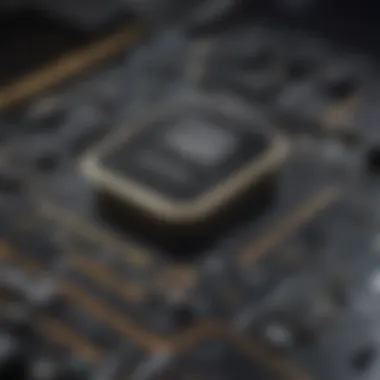AMD Instinct MI200: Pricing, Performance, and Insights


Intro
The AMD Instinct MI200 series represents a significant leap in computing performance, particularly within the realms of artificial intelligence and data centers. This article will dissect its pricing dynamics, performance metrics, and the broader market implications through an analytical lens, allowing both novice and experienced investors to understand its potential impact.
By focusing on key aspects such as market trends, stock performance, investment strategies, and sector-specific insights, we aim to provide a cohesive narrative that informs investment decisions related to this cutting-edge technology.
It is imperative to understand how the evolving landscape of AI and data centers is influenced by advancements like the MI200 series. This exploration not only highlights the competitive dynamics within the technology sector but also equips readers with crucial tools to navigate investment opportunities in a rapidly changing market.
Preface to AMD Instinct MI200
The AMD Instinct MI200 series represents a significant leap in computing performance, especially tailored for high-performance computing (HPC) and artificial intelligence (AI) applications. This introduction serves to contextualize the importance of the MI200 in the competitive landscape of GPUs. As data-driven industries expand, the demand for powerful compute solutions grows. Thus, understanding the MI200's capabilities, pricing, and design is crucial for stakeholders seeking to optimize their infrastructure.
Overview of AMD's Position in the Market
AMD's position in the GPU market has seen a remarkable transformation over the past years. Historically, AMD grappled with a smaller share compared to competitors like NVIDIA. However, with strategic innovations and a clear focus on data centers and AI, AMD has steadily carved out its niche. The MI200 series underscores this shift, as it represents AMD's commitment to driving performance in high-demand sectors.
The rise in cloud computing and machine learning applications has opened pathways for AMD to penetrate markets previously dominated by NVIDIA. By prioritizing specialized hardware suited for AI workloads, AMD aims to attract enterprises requiring efficiency and speed. Furthermore, AMD's competitive pricing strategy enhances its appeal, giving rise to increased market share in the HPC and AI arenas.
Evolution of AMD's Product Line
AMD's product line evolution is marked by a series of strategic advancements that reflect changing technologies and user needs. The transition from traditional consumer graphics cards to specialized computing solutions like the MI200 aligns with broader industry trends focusing on data-centric processing. Each generation of products has built upon its predecessor's strengths, gradually integrating features that address the demands of modern workloads.
The journey began with graphics-focused products, but there has since been a intentional shift towards high-performance computing. The release of the MI200 series is a testament to this evolution, showcasing AMD's adaptive strategy to focus on powerful compute engines that can handle complex AI, data analytics, and deep learning tasks.
In summary, understanding the MI200 series involves recognizing AMD's adaptive roles in a rapidly changing technological landscape. The MI200 not only symbolizes AMD's product lineage but also highlights its aspirations within competitive markets.
Technical Specifications of MI200
The technical specifications of the AMD Instinct MI200 are central to understanding its overall value in the rapidly evolving landscape of high-performance computing. The architecture and design features, along with performance benchmarks, provide crucial insights into how this product stands against its competitors. Moreover, for stakeholders and investors, these specifications indicate the potential returns on investment based on performance metrics observed in similar industries. Thus, discussing the technical specifications equips the readers with the necessary knowledge to make informed decisions when exploring markets influenced by the MI200 series.
Architecture and Design Features
The AMD Instinct MI200 features a robust architecture designed specifically for high throughput and efficiency. It introduces the CDNA 2 architecture, enhancing the computational performance by optimizing different parameters such as memory bandwidth and computational density. Key design aspects include:
- Chiplet Design: This approach leverages multiple chiplets, improving process yield and enabling better performance scaling.
- Infinity Architecture: This technology allows for high-speed interconnects, promoting efficient data transfers across multiple MI200 units within data centers.
- High Memory Bandwidth: Equipped with HBM2e memory, the MI200 provides superior bandwidth, crucial for data-intensive applications seen in AI and machine learning contexts.
Investors and users should note how these design features not only improve throughput but also significantly impact energy efficiency. AMD's focus on scalability and integration assures that the MI200 can adapt to future technological advancements. This adaptability forms an important consideration in the competitive landscape, ensuring that investment in this technology could yield substantial returns based on its longevity and versatility.
Performance Benchmarks
Performance benchmarks provide tangible evidence of how effectively the MI200 operates within its intended applications. AMD claims that the MI200 series offers significant improvements over previous models and its competitors. Some of the key performance metrics include:
- FP32 Performance: The MI200 boasts performance figures that exceed many industry benchmarks, making it suitable for both traditional computing and AI workloads.
- AI Workloads: It is particularly optimized for machine learning tasks, allowing for rapid training and inference processes. Reports indicate up to three times the performance compared to previous generations.
- Benchmark Tests: Independent tests reflect that the MI200 achieves competitive results in benchmarks such as MLPerf and SPEC, reassuring stakeholders about its reliability in real-world application.
In summary, assessing the performance benchmarks against similar products reiterates the MI200's potential effectiveness in critical computing environments. This data is invaluable for those looking to invest in technologies that are growing in demand, particularly as industries increasingly adopt AI and machine-learning capabilities.


"The architecture and performance metrics of the MI200 position it as a strong contender in high-performance computing markets, particularly in AI and Data analytics."
Understanding these specifications allows investors and enthusiasts to grasp not only the potential applications but also the expected longevity of the product amid emerging technologies.
Pricing Structure of AMD Instinct MI200
Understanding the pricing structure of the AMD Instinct MI200 is pivotal in grasping its market positioning and sale strategies. Pricing not only reflects the intrinsic value of the product but also influences purchasing decisions among potential customers. In this section, we will look into the factors influencing the pricing and how MI200 compares to similar products in the industry. This insight will benefit both novice investors and experienced traders in making informed choices.
Factors Influencing Pricing
Several critical elements impact the pricing of the AMD Instinct MI200. Here are some of the key factors to consider:
- Production Costs: The components used in the MI200, such as semiconductors and memory, significantly contribute to the overall production cost. Higher quality materials increase the price.
- Research and Development: AMD invests a substantial amount in R&D to innovate and enhance the performance of their products. This cost is often recuperated through product pricing.
- Market Demand: The demand for high-performance computing products can cause fluctuations in pricing. In sectors like AI and machine learning, the need for faster and more efficient hardware is increasing.
- Competitor Pricing: Pricing strategies of competitors like NVIDIA may influence AMD's pricing. Staying competitive requires price adjustments in line with evolving market conditions.
- Target Demographics: The MI200 is aimed at data centers and enterprises that require robust computing power. Pricing is set according to what these target customers are willing to pay.
These factors collectively shape the pricing landscape for the MI200. It is essential to recognize that understanding these variables can aid investors in assessing the product's value in a competitive market.
Comparative Pricing Analysis
To further comprehend the value of the AMD Instinct MI200, a comparative analysis with alternative products is necessary. The following points illustrate this:
- AMD Instinct MI200 vs. NVIDIA A100: The MI200 is often compared with NVIDIA’s A100 for its target audience and application. While the AMD MI200 might offer better price-to-performance ratios in some benchmarks, NVIDIA’s ecosystem support remains a strong selling point for customers already invested in their technology.
- Pricing Trends: Observing historical pricing trends of similar products can provide insights into the MI200's offerings. The rate of advancements in technology, combined with economic factors, tends to correlate with changing price structures.
- Value Proposition: Customers must weigh the cost against performance. The MI200’s ability to cater to specific applications in AI and computation frequently justifies its pricing.
- Market Sentiment: Feedback and perception within investor communities can influence pricing strategies. Engaging with platforms like reddit.com or forums associated with technology can yield public sentiment and insights significantly impacting AMD’s pricing decisions.
Market Demand and Target Audience
Understanding market demand and identifying the target audience for the AMD Instinct MI200 are crucial for evaluating its overall success and viability in competitive sectors, notably AI and data centers. The demand for high-performance computing solutions continues to grow, driven by the increasing complexity of tasks in the data-intensive world. As companies require more sophisticated technologies to handle large datasets, the MI200 positions itself as a leading choice due to its robust architecture and capabilities. This section will delve into the key market segments and customer profiles associated with the MI200, providing insights that can help investors, developers, and decision-makers understand its potential.
Identifying Key Market Segments
The primary market segments for the AMD Instinct MI200 include:
- Data Centers: These facilities demand high processing power, increased data throughput, and energy efficiency. MI200 aligns well with these needs, providing excellent performance for cloud services, enterprise applications, and storage solutions.
- Artificial Intelligence and Machine Learning: The MI200 is specially designed for AI workloads, enabling rapid training and inference. This sector represents a dynamic and growing market, crucial for applications ranging from autonomous systems to advanced analytics.
- High-Performance Computing (HPC): Industries engaged in complex simulations, scientific research, and computational modeling find significant value in high-performance computing capabilities, which the MI200 delivers.
- Financial Services: In this sector, rapid data processing and real-time analytics are crucial. The MI200 can enhance trading algorithms and risk modeling, making it a strong candidate for financial institutions.
Market segmentation reveals that the MI200 has a broad appeal across various sectors, highlighting the product's versatility.
Customer Profiles and Use Cases
Different customer profiles emerge when analyzing the demand for the MI200. Here are a few noteworthy examples:
- Enterprise IT Managers: These professionals seek cost-effective solutions that provide the power necessary for ongoing digital transformation projects. They aim for a balance of performance and efficiency, essential in managing both operational costs and expectations.
- AI Researchers and Developers: This group focuses on tools that can accelerate their machine learning models. They typically work with large datasets and require hardware that minimizes training time while maximizing output quality. MI200’s architecture is notably suited for these requirements.
- Scientists and Engineers in HPC: These users look for computational power that can handle vast simulations and modeling tasks. They demand precision and performance, making the MI200 a compelling choice due to its remarkable benchmarking results.
- Data Analysts in Financial Services: These customers need high performance for immediate analysis and insight generation. The MI200 is attractive for its ability to quickly process data, aiding in strategic decision-making and improving efficiency.
Identifying the diverse customer profiles and their specific use cases allows businesses and investors to understand how the MI200 meets real-world needs. This insight is invaluable for assessing potential market impact and driving adoption among key user groups.
By strategically targeting these segments, AMD can effectively cater to the distinct requirements, enhancing its positioning in a competitive landscape.
Competitor Analysis


Competitor analysis is an essential aspect of understanding the landscape surrounding the AMD Instinct MI200 series. It provides insights into how this product performs against offerings from rival companies, primarily NVIDIA, but also other brands in the GPU market. This comparison not only highlights AMD's strengths and weaknesses but also showcases market dynamics, helping investors grasp the competitive edge of the MI200.
The significance of analyzing competitors lies in the implications it has for pricing strategies, feature sets, and overall market positioning. As AMD aims to capture a larger share of the high-performance computing sector, recognizing where it stands against NVIDIA's A100 and 00 models, for instance, is crucial. *
Comparison with NVIDIA and Other Brands
When it comes to high-performance GPUs, NVIDIA dominates a large portion of the market. Products like the NVIDIA A100 and 00 provide formidable competition to the AMD Instinct MI200. These NVIDIA models are renowned for their efficiency in AI, machine learning, and deep learning applications.
- Performance Metrics: NVIDIA's products often lead in benchmarks, particularly in training AI models. However, AMD is closing the performance gap, especially with the advancements brought by the MI200 architecture.
- Pricing Strategy: NVIDIA has been criticized for its pricing policy, which at times can be steep. The MI200, while still premium, may offer better value for its performance in specific applications, which can attract price-sensitive customers.
- Ecosystem Compatibility: NVIDIA’s CUDA ecosystem offers extensive support which makes integrating their GPUs into existing systems easier. AMD is improving its software stack, but it still faces an uphill battle in terms of adoption rates in established environments.
Despite these challenges, AMD brings unique features such as scalability in data centers and an embrace for open-source technologies, which may appeal to certain market segments.
Market Trends and Shifts
The GPU market is rapidly evolving, with trends indicating a shift towards more hybrid solutions and energy-efficient computing. The increasing demand for AI capabilities and machine learning proficiency is reshaping product development strategies.
- Emerging Technologies: As AI becomes more integrated into business operations, GPUs that excel in these environments are in high demand. The MI200 is tailored for these needs, focusing on performance optimization for AI workloads.
- Sustainability: There is a rising awareness of the energy consumption related to computing. AMD's focus on energy-efficient designs may position the MI200 favorably as businesses aim for greener solutions.
- Market Entry: New players in the market also increase competition. Companies focusing on niche segments could influence AMD's strategies, pushing them to innovate quicker.
In summary, competitor analysis provides valuable context for understanding the AMD Instinct MI200's positioning. It highlights relative strengths and areas that require focus to ensure AMD maintains competitiveness in a rapidly changing technology landscape.
"In a competitive market, understanding one's rivals is as crucial as understanding the product itself."
Applications and Use Cases
The AMD Instinct MI200 series stands out due to its versatile applications and robust performance across various sectors. Understanding these use cases is crucial for stakeholders evaluating investment or operational strategies. This section will detail three primary areas where the MI200 excels: data centers and high-performance computing (HPC), artificial intelligence and machine learning, and simulation and modeling. Each subheading will explore specific elements, benefits, and considerations for integrating the MI200 into existing frameworks in these domains.
Data Centers and HPC
Data centers have transformed significantly in recent years. The demand for higher computational power has led to the adoption of advanced systems like the AMD Instinct MI200. This GPU architecture delivers impressive parallel processing capabilities, essential for handling large datasets.
- Efficiency: The MI200 series offers high performance per watt, which means that data centers can run more efficiently with lower energy costs, a significant factor in long-term budgets.
- Scalability: As organizations grow, their data processing needs expand. The MI200's architecture allows for seamless scalability from small workloads to extensive HPC tasks, making it suitable for various applications.
- Cost-Effectiveness: Compared to some competitors, the pricing structure for the MI200 can yield a better return on investment over time, especially for data centers that perform constant and intensive processing tasks.
These features position the MI200 as a robust choice for data centers focusing on high-performance workloads and energy efficiency.
Artificial Intelligence and Machine Learning
The rise of artificial intelligence and machine learning has created a need for powerful computing platforms that can handle complex algorithms and massive datasets. The AMD Instinct MI200 series is designed with these requirements in mind.
- Deep Learning: The MI200 excels in deep learning tasks, offering faster training times for neural networks. This capability gives organizations a competitive edge in developing AI solutions.
- Flexibility: Engineers can use the MI200 for diverse AI applications, from natural language processing to computer vision. Its versatility allows for broader experimentation and innovation within teams.
- Support for Frameworks: Its compatibility with popular AI frameworks, like TensorFlow and PyTorch, makes it straightforward for developers to integrate the MI200 into their existing projects, reducing the time required to adopt new technology.
Overall, the MI200 serves as a pivotal tool for companies looking to leverage artificial intelligence in their strategies.
Simulation and Modeling
In fields such as aerospace, automotive, and healthcare, simulation and modeling play a critical role in research and product development. Accurate simulations can lead to better designs and faster innovation cycles, areas where the AMD Instinct MI200 can significantly contribute.


- Real-Time Processing: The computational power of the MI200 allows for real-time data processing during simulations, enabling more dynamic testing environments and reducing iteration cycles.
- High Fidelity: With the MI200's advanced capabilities, users can achieve higher fidelity in simulations. This means the results can be closer to real-world outcomes, which is especially vital in safety-critical industries.
- Interactivity: The MI200 enables interactive simulation experiences, where users can modify parameters on-the-fly and immediately see outcomes. This capability facilitates better decision-making and enhances collaborative efforts among teams.
The MI200 thus supports sophisticated simulations, allowing industries to innovate rapidly while maintaining accuracy. In summary, the ubiquity of the AMD Instinct MI200 across data centers, AI, and simulations reflects its multifaceted utility and growing importance in various sectors.
Investment Opportunities Surrounding MI200
The AMD Instinct MI200 series presents significant investment possibilities that could attract both novice and seasoned investors alike. It is crucial to analyze how this product fits into the broader AI and data center markets. As companies increasingly rely on advanced computing capabilities, the MI200's technical features align well with industry demands. Investors should carefully consider the potential for profitability as the technology matures.
Key factors driving investment interest in the MI200 include its high-performance specifications and technological advancements tailored for a range of computing workloads. These elements make it an appealing option for organizations looking to enhance operational efficiency.
Long-Term Projections
Looking ahead, predictions for the upcoming years suggest that the demand for powerful compute solutions will continue to escalate. With the ongoing expansion of AI and data analytics, the AMD Instinct MI200 is likely to play a central role in powering future innovations. As organizations strive to process vast data sets faster, the MI200's capabilities are well-positioned to cater to this need, enhancing its attractiveness in the investment landscape.
Potential long-term benefits include:
- Growing Adoption in Data Centers: As more businesses migrate towards cloud computing and data centers, the need for robust GPUs like MI200 increases.
- Innovation Cycle: AMD’s commitment to regular architectural improvements may lead to consistent demand for its products.
- Infrastructure Investments: Government and private-sector investments in AI infrastructure could enhance market positioning for AMD.
Risks and Considerations
Despite the promising outlook, there are inherent risks investors should acknowledge. Understanding these risks is key to making informed decisions that align with one's investment strategy.
Factors to consider include:
- Market Competition: The presence of strong competitors, particularly NVIDIA, could pressure pricing and demand for the MI200 series.
- Rapid Technological Changes: The tech industry is characterized by swift developments, which may make current technologies obsolete.
- Economic Factors: Global economic conditions directly influence corporate spending in technology. Downturns could limit budget allocations for new hardware.
"Investors must navigate the delicate balance between existing opportunities and the potential barriers posed by market dynamics."
As investors assess the opportunities surrounding the AMD Instinct MI200, it is important to weigh both the potential rewards and risks. A strategic approach that considers long-term projections alongside industry challenges can promote better investment outcomes.
End
The conclusion serves as a crucial capstone to our detailed analysis of the AMD Instinct MI200 series. In this section, we draw together the threads of performance metrics, pricing dynamics, and market context, underscoring their collective impact on potential investment strategies. The MI200 is not just another GPU; its features create significant implications for businesses focused on high-performance computing and artificial intelligence sectors.
This article has illustrated how the MI200's advanced architecture positions it competitively against its peers, particularly NVIDIA's offerings. Understanding these dynamics helps investors recognize the nuanced portfolio adaptations necessary in an evolving market landscape. Here, we emphasize the importance of recognizing key performance indicators, the observed pricing trends, and the competitive analysis foccusing on how these factors interplay in differentiating market opportunities.
Summarizing Key Insights
The AMD Instinct MI200 series stands out amidst its competitors for several reasons:
- Performance Efficiency: It delivers high computational power. Its architecture allows for optimized processing in demanding applications, a feature attractive to data centers.
- Adaptive Pricing Structures: The MI200's pricing reflects its capabilities while also competing with established brands. Understanding this pricing strategy is essential for investors looking at ROI potential.
- Market Relevance: The MI200 aligns with current trends towards high-performance computing and AI, indicating strong market demand, essential for sustained growth.
These factors combine to present a clear picture of where AMD positions itself in a competitive field. This awareness allows investors to make informed decisions and capitalize on the emerging trends in the technology space.
Final Recommendations
After thoroughly examining the AMD Instinct MI200 and its market context, here are several recommendations:
- Monitor Competitive Movements: Keeping an eye on AMD’s competitors, especially NVIDIA, and how market shifts may affect the MI200's performance is crucial. Consider utilizing platforms like reddit.com for ongoing discussions and insights.
- Evaluate Long-term Viability: The investment in MI200 appears advantageous, especially with the projected demand for AI and HPC. However, assess the longevity of tech trends and innovations in this sector.
- Explore Collaborative Opportunities: For technology companies, looking into partnerships or uses of the MI200 in innovative applications can yield fresh insights for business development.
Thus, as the market evolves, so should the strategies that investors employ, particularly concerning highly transformative products like the AMD Instinct MI200.



